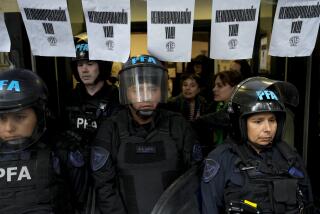2 Latin Nations Seek a Common Market
- Share via
RIO DE JANEIRO — Brazil and Argentina, the ailing giants of South America, are trying to salvage their crumbling economies by starting a common market modeled after Europe and the United States.
The traditional rivals say cooperation is the only way for Latin America to head off economic disaster.
“There aren’t many options. Either we work out a joint strategy in line with our development needs, or we will be the objects of outside strategies,” Argentine President Carlos Menem told Brazil’s Congress during a three-day visit in August.
Burdened by stagnant growth, four-digit inflation and a combined foreign debt of about $170 billion, Brazil and Argentina have knocked down some trade barriers and recently agreed to boost trade and cooperation to unprecedented levels.
The idea is not new. In the last three decades, an array of organizations--the Latin American Assn. of Free Commerce, the Andean Pact, the Latin American Development Assn. and, most recently, the Latin American Economic System--were devised to unite Latin American economies.
All failed, mostly because of excessive protectionism, nationalism and cultural antagonism.
But this time around, Latin American leaders say they can lick the problem by starting small.
Tiny Uruguay, which borders the two giants, recently joined Brazil and Argentina in the common market scheme. Now, these three countries hope to attract other nations to the fold, or at least to set an example for other regional trade blocs.
“It’s the only way for Latin America to create a common market,” said Helio Jaguaribe, director of research at Rio de Janeiro’s Institute of Political & Social Research. “The Brazil-Argentina accords have become a spotlight for other countries to follow.”
The renewed interest in a Latin common market was sparked by the growth of trade alliances in Western Europe, between the United States and Canada, and between Japan and its Asian neighbors, analysts say.
“Integration is fundamental,” Fernando Collor de Mello, Brazil’s leading presidential candidate, said recently. “Latin America cannot be left out of this new world order.”
Increasingly, the region’s leaders are dismantling or selling off the powerful but often inefficient state-run enterprises and turning to free market principles.
The return of civilian regimes in much of Latin America also has helped foster mutual trust and economic liberalism that was lacking under military rule, when generals were more concerned with “national security.”
“The old military governments hardly wanted to share their secrets or strengths with their neighbors,” said Paulo Rabello de Castro, a private economic consultant in Rio and managing editor of the respected financial monthly Conjutora Economica. He said mutual suspicion no longer exists.
Indeed, Menem and Sarney recently signed agreements to swap military, space and nuclear technology and increase cultural exchange programs.
The growth of Latin American industry also will boost integration, economists say.
Nations such as Venezuela, Chile, Brazil and Argentina are no longer as dependent on foreign technology as they were 30 years ago. Today, they can trade a wide variety of products and resources without foreign assistance.
“The integration gears are meshing,” De Castro said. “By early next century a common market scheme could be in place complete with a regional judiciary system.”
But large hurdles remain.
The current economic woes of Argentina and Brazil have left those countries without the funds needed to support and finance a continent-wide market, said economist Carlos Alberto Primo Braga, a visiting professor at the Johns Hopkins School of Advanced International Studies.
“It’s hard to achieve integration when the region’s economies are in recession,” said economist Celso Furtado, a former Brazilian planning minister. “The last thing fragile, internal industries will want is competition from other countries.”
Many analysts say economic growth needed to foster a common market will only start when the continent’s $440-billion foreign debt becomes less of a burden.
Argentina is virtually bankrupt and $4.5 billion behind in payments on its $60-billion foreign debt.
Even Brazil, which boasts the world’s eighth-biggest economy and the third-largest trade surplus, spends most of its export earnings to pay interest on its $110-billion foreign debt, the Third World’s largest.
To ease the burden, Latin leaders are considering proposals to swap foreign debt to create a Latin American common market fund, according to Aloizio Mercadante Oliva, professor of economics at Sao Paulo’s Catholic University.
Another obstacle is the lack of a strong local currency. The value of Brazil’s new cruzado drops daily, and Argentina’s austral has plummeted more than 97% against the U.S. dollar in the last five months.
“We’d have a tough time trading even shoelaces with our funny money,” said De Castro.
To cope with the “funny money” problem, Brazil and Argentina have a $500-million reciprocal credit agreement under which they import and export each others’ products without the use of currency.
Large trade imbalances between nations and a reluctance to loan cash and share technology continue to impede integration, analysts say.
Indeed, since South America’s two largest trading partners announced their common market plans in 1985, Brazil has run up a $500-million trade surplus with Argentina.
But that too may be changing. Brazil in August agreed to accept up to $350 million worth of Argentine-financed projects for transportation, hospital construction and hydroelectric equipment.
More to Read
Sign up for Essential California
The most important California stories and recommendations in your inbox every morning.
You may occasionally receive promotional content from the Los Angeles Times.













